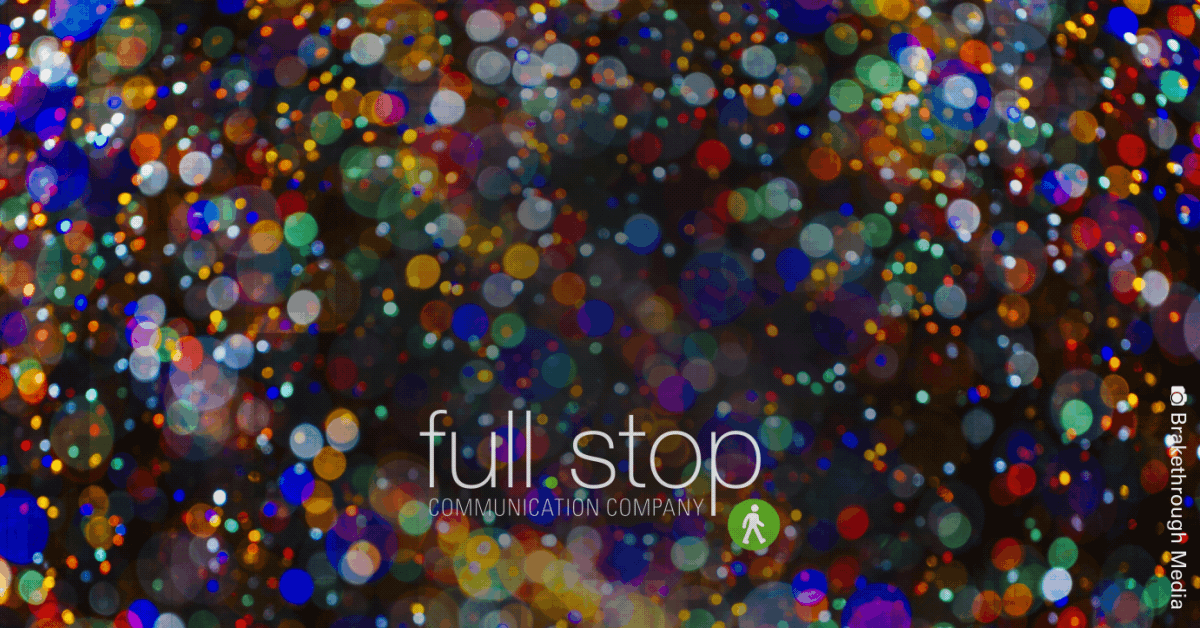To a peaceful* 2022
Are you ready for 2022? We know we are! Happy holidays from the full.stop crew!
Best of Atlas Copco’s 2020
Always a joy to work with, Atlas Copco kept us busy in 2020. Happy and proud to have made the Industrial Air ‘Best of’ video reel. #lovetechnicalB2Bcommunication
It’s time to change how you think about video
The use of video marketing has exploded and it’s easy to see why. After all, video allows companies to connect with customers in a more effective and personal way.
However, companies with small marketing budgets often shy away from adding video to their communication mix because they believe that this might be too costly. Fortunately, that perception is increasingly incorrect.
Take advantage of video marketing
Nowadays, you don’t need much more than a phone or a computer to get started. Of course, it also helps to get expert advice. That’s why we spoke with Lou Bortone, a veteran in video communication, trusted adviser to hundreds of companies, and author of “Video Marketing Rules,” an essential guide to video marketing.
In this video, Lou explains how anybody can take advantage of video to get their message out with a personal touch.
A marketer’s guide to surviving a recession: don’t slash your budget
Don’t slash your marketing budget in a recession. It is going to make your slump worse and your recovery tougher. As many signs point to an economic downturn, here are some tips on how marketing managers can survive and thrive.
Don’t slash your marketing budget in a recession
When a downturn hits, the first instinct of many companies is to cut costs and lay off people. Often, the marketing department is among the first victims of those cuts. It is a reflection of the outdated belief that marketing (communication) is more of a “nice extra” than a strategic function. However, it is in a tough market that you need marketing’s vision on what, how, when and where to sell the most.
The negative effects of simply cutting human and other resources in the marketing (communications) department don’t take long to materialize. A smaller presence in a tough market is going to generate even less in sales. If only because it communicates to your customers and your competitors that you are struggling.
The negative long-term effects of a defensive approach
A defensive approach to recession management creates negative effects in the long run, too. Profit Impact of Marketing Strategy studies have shown that companies that do not slash their marketing budgets generally benefit down the road. A study published in Harvard Business Review concluded: “Few prevention-focused corporations do well after a recession, according to our study. They trail the other groups, with growth, on average, of 6% in sales and 4% in profits, compared with 13% and 12% for progressive companies. Whereas in the three years after the 2000 recession, sales for the 200 largest companies grew by an average of $12 billion over prerecession levels, the prevention-focused enterprises among them saw sales grow by an average of just $5 billion. Moreover, cost cutting didn’t lead to above-average growth in earnings. Postrecession profits for prevention-focused enterprises typically rose by only $600 million, whereas for progressive companies they increased by an average of $6.6 billion.”
More efficient, not less
Of course, most companies simply have to do with less in a downturn. But if marketing execs have to make cuts, then they should use a scalpel and not a butcher’s knife. In communications, there is always some waste. There is always some money spent on things that don’t generate the intended ROI. Or not anymore. Your customers have changed and so have the tools to reach them. What once worked might not be ideal anymore. So use a (looming) recession to review the effectiveness and efficiency of your communication approach and mix. Maybe you can go all digital instead of using print. Maybe you can shift more of your ad budget to online. There is a good chance you will find inefficiencies that would result in smart rather than blind cuts.
Plan ahead
The recession is not here yet, so there is time to come up with a plan. Don’t wait until stock prices plummet, investments decline and consumer spending slows. If you wait until the finance department tells you to make cuts, there probably isn’t time to do anything but just cut. But if you start working on a plan to increase your department’s effectiveness and efficiency now, you will be ready to implement it when you need to.
Look for opportunities
Keep in mind that a recession does not mean that people and companies will stop buying things altogether. They will just be more mindful of how they spend their money. In addition, the downturn might create new business opportunities: a new market segment, new ways to outsmart your competitors, a new type of customer, new customer needs, etc. The greatest value of marketers during a downturn is in identifying and capitalizing on those opportunities. Rather than giving into recession-induced angst and defensiveness, do what you were hired to do. Find the smartest way to help your company survive and thrive, in the tough times and the recovery that will follow.
Everything is communication
When people think of human communication, they immediately think of written and spoken words. That’s certainly part of it, but humans communicate in so many other ways. A smile can express much more than a formal thank you note. And what a person says can be powerfully contradicted by their body language. After all, everybody who has ever been in a relationship knows that “It’s fine” does not actually mean that everything is fine. It’s the same with business communication. Everything is communication, not just the output of your (marketing) communication team.
Everything is communication
Corporate and marketing communication often gets narrowed down to intended communication. Our customers come to us for a website, video, brochure or press release that is just right. Of course we are happy to make those for you. However, engaging press releases, informative videos, glossy brochures, insta-ready photography, and a website with all the bells and whistles are just a part of how you interact with your stakeholders. These days, everything is communication. It’s…
- how you (don’t) engage with your customers on social media
- the free coffee for customers waiting in your store
- how your office looks
- the typos in your PowerPoint presentation
- how friendly your store manager treats customers and team members
- the long time people have to wait before someone at HQ answers the phone
- …
Your brand is multidimensional and your intended (marketing) communications efforts are just one of those facets. You don’t want it to be the fake-looking one. Everything you do and say as a company sends a message. You need it to be the message you want to send.
Consistently awesome
If your intended and your day-to-day communication don’t match, you run into the issues of brand consistency and authenticity. A “professional-looking” website is useless if your customers go to your office and find it a mess. If you want to be known as a fun and friendly company, then be a fun and friendly company. If not, your customers will quickly realize it’s all just a front. Of course we will make a beautiful brochure for you. We just want to make sure it is part of a 360-degree brand experience that is authentic and consistent and that just connects with your stakeholders.
Map your brand impact
All of this means you do have to broaden your communication horizon. One of the first steps is to understand how your stakeholders experience your brand. Not simply to structure your sales funnel or build your website, but to get an idea of your overall communication footprint and impact. Does it reflect the experience you want your stakeholders to have with your brand? If not, structure every aspect of the way you work (and communicate) to reflect that image. Controlling every bit of communication within your organization might be a mission impossible. But understanding the scope of what and how you communicate will go a long way. Especially because customers and other stakeholders will realize and appreciate that you made an effort. And being known as a company that tries is never a bad thing.
Business stock photos: no laughing matter
Business stock photos have become a joke. Even celebrities have gotten in on the act. It’s easy to see why people make fun of them. The sterile business settings and staged situations as well as all those fake smiles simply lend themselves to ridicule. However, to businesses with a limited marketing budget, stock photos are no laughing matter – they are a necessity. Because many companies can’t afford to hire a photographer – for some or all of their marketing projects. Sometimes you just have to go with stock images. However, there are ways to make them work for you without ending up as the butt of a joke.
The problem with business stock photos
The reason why people make fun of them is that many stock photos are ridiculous. They completely lack authenticity and often seem sooooo cliché. Whether it is everybody having a good time in a meeting (and we all know that those meetings don’t exist), lots of handsome young people pointing at a laptop screen for some reason or those phony smiles, it all just seems so fake.
That is why maintaining authenticity is one of the most important things you should do when using stock photos. Fortunately, you don’t need to have a huge photography budget to pull it off. However, you do have to invest some thought and time into picking the right stock photos (I’ll spare you an image of an office worker staring off into the distance while pondering a problem here).
Make stock photos work for you – a few tips
Most importantly, the stock photos you choose have to illustrate or support your story. You have to figure out what you want to say or represent and then keep looking until you find the perfect stock photo. Because you won’t be able to fool your customers. They know exactly what real office look like, or factory floors or construction sites. And they also know what type of people work there. So let’s forget about picking that stock photo in which a bunch of smiling people stand around in spotless lab coats with ill-fitting hard hats in front of an immaculately clean desk or a machine that has clearly never run for a single day. It should go without saying, but you can’t fake authenticity.
The stock photo you choose doesn’t have to be perfect, but it has to be perfect for you – and you may need to take your time finding it. If the image looks familiar to you – or like a cliché – then keep searching because customers will likely feel the same way.
That is why it helps to think outside the box. Is there a creative way to illustrate your point or highlight your product? Maybe you can use imagery from nature, etc.
Get help
If you think that you can’t do this alone, then find an expert to assist you. While you may not have a big budget to hire your own photographer, it pays to work with a good graphic designer. They have an eye for images and how to make them work, which allows them to see things from a completely different perspective. They can find the photos that most effectively tell your story, can highlight details, add a special effect, etc.
Finally, while there are some major providers of stock photos, such as iStock and Shutterstock, don’t just try to find your image there because they have the largest selection. While they may have exactly what you are looking for, there are many smaller providers out there that make their money by being particularly creative or cater to a niche audience. Their stock photos might be much better suited to tell your story and promote your brand.
If you do all (or most) of the above, there is a good chance that your stock photos won’t be a joke but rather give you the last laugh (cue to an image of a group of 20somethings sharing a laugh in a meeting room).




